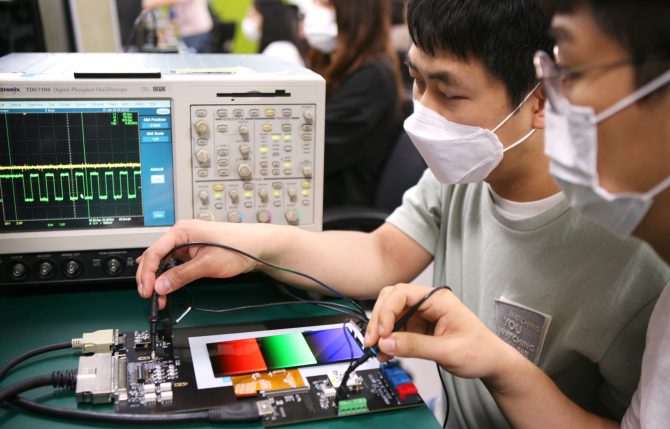
Samsung commercializes new variable refresh rate technology
EP&T Magazine
Electronics adaptive displays frequency OLED‘Adaptive Frequency’ OLED technology supports optimized refresh or scan rate for applications from 10Hz to 120Hz
Samsung Display Company recently revealed new display technology that features an enhanced power-saving function for mobile electronics, being commercialized for the first time in Galaxy Note20 Ultra 5G flagship smartphones. The display company has now successfully commercialized its low-power OLED adaptive frequency technology, which can curtail the operating power of a phone’s display by as much as 22 percent over existing smartphones now in general use.

Engineers from Samsung Display are using testing devices to inspect frequency changes in display panels that feature adaptive frequency technology.
Source: Samsung Displays
“High-definition video streaming and gaming are expanding their capabilities in line with 5G commercialization, creating a widespread need for display panel technologies that can enable greater power savings,” said Ho-Jung Lee, vice-president of the mobile display product planning team for Samsung Display.
“Our Adaptive Frequency display technology is expected to considerably enhance the user experience by calibrating refresh rates in line with the requirements of a specific application and therein more precisely allocating available power. This will free up time for other smartphone operations,” Lee added.
Panel utilizes variable refresh rates that consume the least amount of power
The company’s power-saving technology allows the display panel to utilize variable refresh rates that consume the least possible amount of power for each type of application. The adaptive frequency technology supports a 120Hz scan rate for playing mobile games that require speedy frame changes, a 60Hz rate for movie streaming, a 30Hz rate for email correspondence, and a 10Hz rate for viewing still images or browsing social networking services.
Existing smartphone panels offer only a fixed refresh rate. They cannot automatically calibrate a phone’s refresh rate, which would result in image flickering caused by luminance differences at lower refresh rates. Samsung Display’s new backplane** technology eliminates flickering for operating frequencies as low as 10Hz.
In particular, when displaying still images, the new variable-rate panel has proven to consume operating power of as little as 60 percent by introducing a low-frequency refresh rate of 10Hz, while conventional panels unnecessarily waste power through the use of a consistent, fixed frequency regardless of the type of content.
